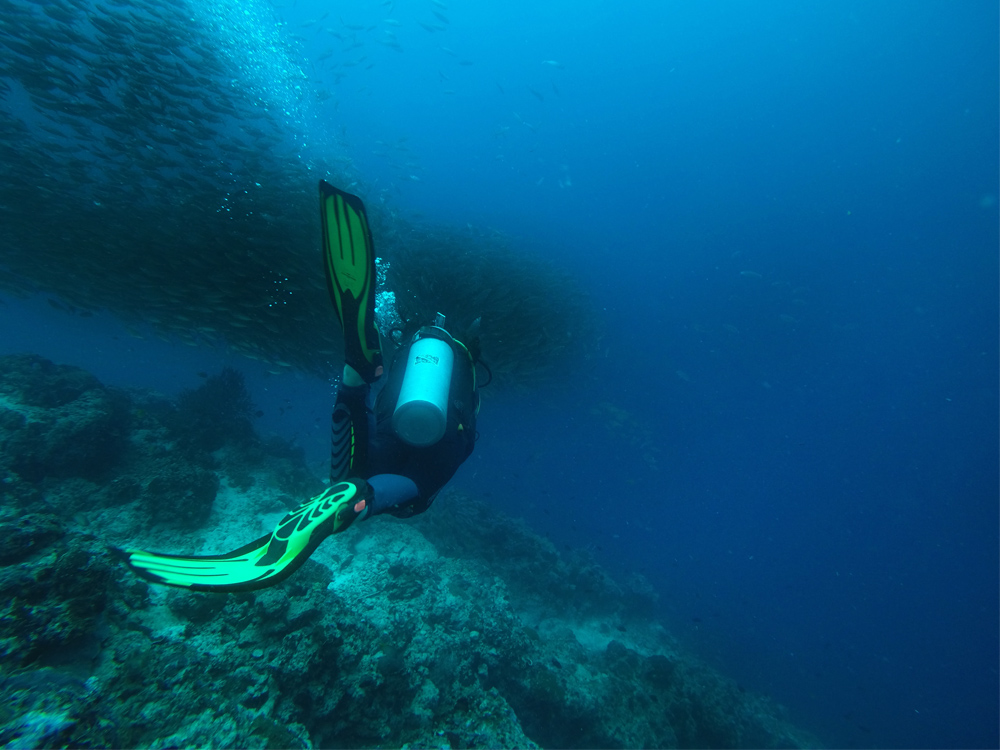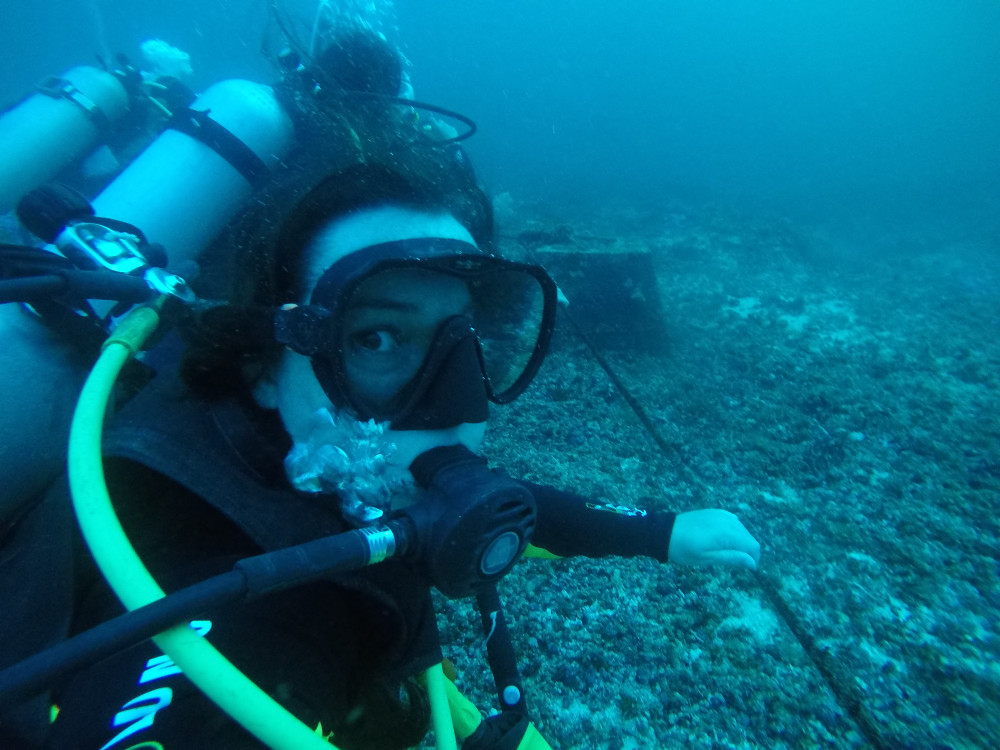Some of the links in this post are affiliate links. This means if you click on the link and purchase the item, I may receive an affiliate commission at no extra cost to you.
Diving with long hair presents unique challenges, from managing tangles to preventing interference with your equipment. No matter where you’re diving, maintaining control over your long hair is essential for comfort and safety. Long hair can easily become entangled in gear, potentially disrupting your dive or just clinging to things it shouldn’t when you’re trying to remove your gear. Fortunately, with a few practical tips and strategies, you can keep your hair in check and better enjoy your dive.
In this article, I share 8 tips for diving with long hair. I myself have long hair and I don’t see that changing anytime soon, so I have real lived experience with this issue. From the benefits of using nifty accessories like dive caps and neoprene mask straps to techniques for preventing tangles and managing hair care afterwards, I share a range of ideas to help you dive with long hair more comfortably.
#1 Braid or Tie Up Your Hair
Before gearing up for your dive, it’s a good idea to braid or securely tie back your hair to prevent it from becoming a nuisance underwater. Putting your (dry) hair into tight braid or a low ponytail can significantly reduce the chances of your hair tangling or getting caught in your scuba gear. Just make sure you don’t tie it in a way that will cause discomfort once your mask is on.
If your hair is really long, braids might be a better option or doing a pony tail but with multi hair ties placed down the length of your pony. This will stop the hair from floating outwards. A low bun can work but I find its more hassle than its worth. It either gets in the way of the mask or it gets caught when you try to remove the hair tie afterwards.
This simple preparation not only keeps your hair manageable but also ensures that it doesn’t interfere with the fit of your wetsuit or mask. Cause if your hair gets caught under the side of your mask water can seep in. By taking a few extra minutes to secure your hair before donning your gear, you’ll have one less thing to worry about while under the waves.
Not only do you not want your hair flying around underwater, its also a pain once you surface and have to deal with messy, tangled hair while taking your gear off. If you’ve been in salt water, you’ll have the bonus of your hair feeling coarse and gross while you’re trying to get it under control. Personally, I tie mine up into a pony tail then don’t touch it until I’m back at the hotel where I can shampoo the salt water out.
#2 Wash Your Hair

Which leads me to my next tip: After completing your dive, rinse your hair thoroughly with fresh water as soon as possible. This step helps remove any residual salt, chlorine, or sand that may have accumulated during your dive. Saltwater and chlorine can dry out and damage your hair, leading to potential breakage and tangling if not promptly washed out.
I do this religiously because I hate the way my hair feels after an ocean dive. I know ocean hair can look cute on some people but after being 18 metres under, I look more like a walking birds nest than anything else. Its not worth trying to comb, its best to hop straight in the shower and cleanse the moisture back into your hair.
#3 Wear a Hood
I personally have never done this yet but I have seen others do it and recommend it to keep your long hair under control while scuba diving. Neoprene hoods are particularly useful in cold water dives, but can be worn in most dive situations.
I’d recommend choosing one that is easy to take on and off. I personally think the ones that velcro around your chin would be least likely to pull your hair while putting them on and off. However go into a dive store and try them on to see what works best for you. I could see myself getting annoyed trying to get the full head and neck options off after a dive. Ofcourse, if you need the fuller option for warmth, go with that. Safety first.
#4 Use a Diving Rag
Another option is to use a diving rag, which is kind of like a dorag or a bandanna but is suitable for underwater use. These can be great as they don’t add as much heat as a hood, but can help keep the top half of your hair in place.
Diving rag are especially good if you have flyaways or baby hairs that you want to protect from the waves.
#5 Wear a Swimming Cap
Yes, that’s right. One of those brightly coloured things you were encouraged to wear at your primary school swimming carnival. Similar to a diving rag, but these are more snug. This option is best for medium length hair as with super long hair you may have some issues getting all of your hair tucked in.
You have two main options which are silicone and rubber for a classic swimming cap. I find that rubber holds your hair in place better, and better holds it to your head. However I find rubber more annoying to take off as it can pull your hair. Silicone is a better option in my opinion as it is easier to get on and off, and its still pretty good at keeping the cap on your head.
Likewise with the diving rag, it would be best in warmer places as it wont add too much heat to your body.
My only concern would be if air could get trapped in the cap, so I wouldn’t go for this option on a deep dive, but for 10 metres or less it would work. I personally haven’t had that problem but I have never tried it when going too deep. If you’re doing a deeper dive opt for a neoprene cap instead. This is the same materials as a hood, but looks like a beanie and is a bit more lightweight.
#6 Ditch the Snorkel

This one can be controversial, and will depend on the conditions where you dive, but leaving the snorkel behind means one less thing for your hair to get caught on. I personally don’t love snorkels attached to masks and I have only once used one when the waves were super choppy.
Having a snorkel dangling around your face and hair floating around, chances are they’ll probably find each other and connect at some point. I find even when I put my hair in braids I’ll still hae a road side hair that wants to intimately know my snorkel. So I have started leaving mine behind and haven’t had any issues yet.
If you’re not sure, check with your dive master/ guide while setting up for the dive. They’ll be able to tell you if you’ll likely need one after ascending.
#7 Neoprene Mask Strap
Unlike traditional straps, neoprene straps offer a cushioned, soft feel that lessens the pressure on the back of your head and prevents your hair from getting snagged. They are also adjustable, improve overall mask stability and reduce the need for constant readjustment while diving.
These straps are quite helpful if you find the normal mask straps pull your hair when you adjust them. The neoprene straps keep your mask tight to your head, but offers a bit more comfort in their usage. I have tried one previously but do not yet own one (but its on my wish list). This would be one of my top picks as my hair always gets caught.
#8 Hair Cut?
While I think this one is a cop out, if you do have a lot of diving coming up and wouldn’t mind testing out shorter hair anyway, this can be a good option. Lo hair, lo problems, as they say. With less hair you could get away with a ponytail and a bang wrangler (if you need one).
As you can see there are a few options to help you scuba dive with long hair. I always used to dread the effect diving had on my hair but have found some of these methods really helpful.
For me, I love a pony tail with multiple hair ties, then making sure I wash my hair soon after. Also, as mentioned earlier, one of those neoprene mask straps is on my wish list too. I find simple is best for me. I hope these tips help you dive with less annoyance in the future.
Leave a Reply